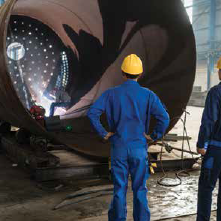How Welding Inspection Racine Makes Sure Safety And Security and Conformity
How Welding Inspection Racine Makes Sure Safety And Security and Conformity
Blog Article
Cutting-edge Strategies to Fillet Weld Inspection and Screening: Enhancing Weld Top Quality and Conformity Standards
In the world of welding, the quality and integrity of fillet welds play an essential function in guaranteeing the architectural strength and reliability of different commercial elements. With the constant drive for improved effectiveness and compliance with stringent requirements, the expedition of ingenious strategies to fillet weld evaluation and screening has actually become important.
Advanced Non-Destructive Screening Techniques
Making use of cutting edge modern technologies, advanced non-destructive testing techniques play a crucial function in guaranteeing the honesty and high quality of fillet welds. These approaches, such as phased array ultrasonic testing (PAUT) and magnetic fragment testing (MPT), offer in-depth understandings into the weld's interior framework without creating any kind of damage to the material. PAUT, for circumstances, makes use of multiple ultrasonic aspects to check the weld from numerous angles, offering a detailed visualization of possible problems like absence of blend or splits.
Likewise, MPT works in detecting surface-breaking defects by applying an electromagnetic field and iron bits to the weld location. This method is particularly helpful for determining discontinuities that may jeopardize the weld's toughness. By using these sophisticated non-destructive screening methods, weld examiners can precisely examine the top quality of fillet welds, making certain conformity with sector criteria and laws. The ability to spot defects early not only improves weld high quality but also prevents costly rework or failures in architectural integrity, underlining the significance of these innovative screening techniques in welding assessments.
Robotics and Automation in Assessment
The integration of robotics and automation has actually reinvented the inspection procedure for fillet welds, enhancing performance and accuracy in high quality evaluation. Robotics provide precise control and repeatability in examining welds, ensuring regular and reputable results. Automated systems can be configured to follow certain evaluation courses, guaranteeing detailed protection of welds and lowering the risk of human mistake.
Robotic assessment systems outfitted with advanced sensing units can detect and determine weld attributes with high precision, giving in-depth data for analysis. These systems can recognize defects such as cracks, absence of blend, and porosity, enabling timely rehabilitative activities to be taken. In addition, robotics and automation enable for real-time information collection and evaluation, providing instant responses to operators and helping with fast decision-making procedures.
Additionally, using robotics and automation in fillet weld examination improves overall efficiency by minimizing examination times and increasing evaluation throughput. By simplifying the examination process, suppliers can guarantee weld high quality and conformity criteria are fulfilled successfully, ultimately resulting in cost savings and improved product top quality.
Making Use Of Expert System for Analysis
Artificial intelligence plays a pivotal role in enhancing the efficiency and precision of evaluation in fillet weld evaluation processes. By utilizing the power of AI, inspectors can streamline the evaluation of weld top quality and conformity criteria, causing a lot more trustworthy and exact results. AI algorithms can rapidly refine substantial quantities of data from weld evaluations, discovering problems or inconsistencies that may be testing to understand the nude eye. This innovative modern look at here technology allows real-time tracking of weld quality, permitting prompt restorative activities to be taken if any kind of problems are found.
Additionally, AI systems can pick up from past examination data, continuously boosting their ability to identify prospective issues and deviations in fillet welds. This adaptive discovering capacity boosts the total quality assurance process, minimizing the chance of human mistake and ensuring that welds meet the required requirements. By incorporating fabricated intelligence into fillet weld analysis, markets can attain greater degrees of performance, uniformity, and conformity in their inspection practices.
Portable Tools for On-Site Evaluation
 Enhancing field inspection effectiveness, the fostering of mobile devices changes on-site analysis processes for fillet welds. These tools provide versatility and ease, allowing assessors to perform extensive assessments in numerous places, consisting of challenging or remote atmospheres. Mobile devices such as ultrasonic testing tools, magnetic particle evaluation devices, and digital radiography systems offer real-time data and high-resolution imaging capabilities, enabling fast decision-making and instant comments on weld high quality.
Enhancing field inspection effectiveness, the fostering of mobile devices changes on-site analysis processes for fillet welds. These tools provide versatility and ease, allowing assessors to perform extensive assessments in numerous places, consisting of challenging or remote atmospheres. Mobile devices such as ultrasonic testing tools, magnetic particle evaluation devices, and digital radiography systems offer real-time data and high-resolution imaging capabilities, enabling fast decision-making and instant comments on weld high quality.One substantial advantage of portable devices is their capability to enhance assessment procedures, reducing downtime and improving general efficiency. Inspectors can conveniently move these devices to different job websites, getting rid of the requirement for transferring heavy equipment or components to off-site centers. In addition, the transportability of these devices promotes cost-effectiveness by minimizing transport costs and accelerating examination timelines.
Additionally, using mobile tools for on-site examination advertises proactive quality assurance steps, as inspectors can without delay recognize and deal with any type of potential welding flaws or disparities. By incorporating these innovative technologies into on-site inspection methods, welding professionals can make sure conformity with market criteria and enhance weld high quality, ultimately causing improved structural honesty and safety in different Bonuses welding applications.
Assimilation of Data Administration Equipment
Having maximized on-site inspection processes with the utilization of portable devices, the following phase includes the smooth combination of information monitoring systems to further enhance effectiveness and information evaluation capabilities in fillet weld evaluation and screening. Welding Inspection Racine. By incorporating data administration systems right into the examination procedure, organizations can improve data collection, storage, and analysis. This combination enables real-time surveillance of weld top quality, prompt identification of defects, and prompt decision-making to correct any type of problems that may emerge during the evaluation process
Data administration systems play a crucial role in centralizing inspection data, helping with very easy gain access to for licensed workers, and making certain information honesty and safety. With the combination of these systems, examiners can produce extensive reports, track historic information for pattern analysis, and improve overall procedure performance. The assimilation of information administration systems enables smooth communication between browse around this web-site various stakeholders included in the evaluation procedure, fostering collaboration and boosting general quality control actions. Eventually, the integration of information monitoring systems offers to raise the standards of fillet weld assessment and testing, making sure compliance with sector guidelines and enhancing weld top quality.
Verdict
Finally, ingenious strategies to fillet weld inspection and testing have actually considerably boosted weld quality and compliance criteria. Advanced non-destructive screening methods, robotics, automation, expert system, mobile devices, and information management systems have transformed the method weld examinations are performed. By making use of these technologies, markets can ensure that welds meet the required quality requirements and regulations, inevitably improving overall effectiveness and safety in welding processes.

By utilizing these sophisticated non-destructive screening techniques, weld assessors can properly analyze the top quality of fillet welds, making certain conformity with market requirements and regulations. Mobile tools such as ultrasonic testing tools, magnetic particle evaluation tools, and electronic radiography systems provide real-time data and high-resolution imaging capacities, allowing quick decision-making and immediate feedback on weld top quality.
Having actually enhanced on-site inspection procedures with the usage of portable devices, the next phase includes the seamless assimilation of information management systems to further boost effectiveness and data evaluation capabilities in fillet weld inspection and screening (Welding Inspection Racine). Inevitably, the combination of data management systems serves to boost the standards of fillet weld assessment and testing, ensuring compliance with market policies and boosting weld top quality
 In final thought, innovative techniques to fillet weld examination and screening have actually substantially boosted weld top quality and compliance criteria.
In final thought, innovative techniques to fillet weld examination and screening have actually substantially boosted weld top quality and compliance criteria.Report this page